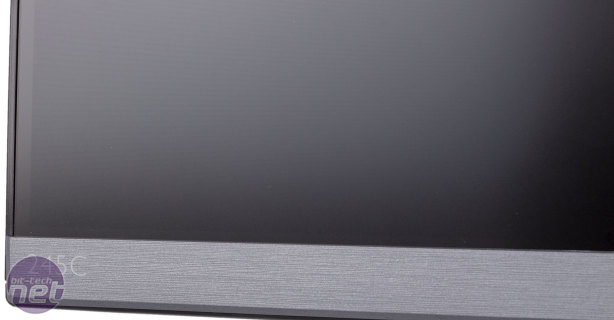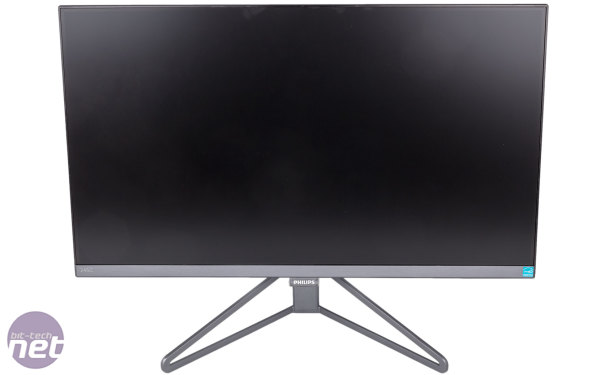
Performance Analysis
Initial impressions of the screen were good. Viewing angles, for example, hold up fairly well – they're not the best we've seen, but they're a massive improvement over what you get with TN-based screens. This is important for a monitor like this that lends itself well to multi-monitor setups where viewing angles won't be head-on. Our usual test images displayed with nice, vibrant colours and contrast seemed okay as well, although black details were a little crushed in darker areas. An all-black image reveals a little bit of backlight bleed around the edges although not intolerable amounts.Moving on to the colorimeter results, the Ultra-Wide Color feature clearly does have an impact, as the 245C7QJSB achieves 100 percent sRGB coverage and 87 percent AdobeRGB coverage, with this latter result being considerably higher than the usual mid-70s results for standard gamut screens, but it won't be enough to satisfy professionals looking for a true wide gamut display.
Measured contrast could be improved, but it's not a disaster. The screen is able to achieve its claimed 250cd/m2 brightness, and the default white point of 6,300K is nice and close to the ideal value of 6,500K.
Colour accuracy is fantastic; a delta E value of less than 1 is a brilliant result for a sub-£200 screen, and no single colour is amiss by too much, as even the maximum is below 3. This puts it on par with the similar ViewSonic VX2776-smhd. Gamma is a touch higher than it should be with a measured value of 2.3, perhaps explaining the overly dark areas we mentioned earlier, but the curve follows the ideal one pretty closely nonetheless.
Uniformity of colour and luminance is an area where the 245C7QJSB could improve and perhaps its weakest area, although again it's not a terrible set of results, as the real-world, noticeable impact is minimal.
Calibrating the screen did have a positive impact; we noticed a slightly cooler image overall, and orange hues that were previously a bit overdone were dampened, resulting in slightly more neutral and natural looking skin tones, for example. That said, it didn't make a massive difference, and you should only bother investing in a colorimeter if colour accuracy is super important.
Finally, we ran a few games to get a sense of the screen's performance there. Given that it's a 60Hz monitor without variable refresh rate support and a relatively slow response time, you won't be surprised to learn that we've had numerous better experiences elsewhere. If you want the best experience possible, you'll want to seek out a screen with FreeSync or G-Sync and a high refresh rate. Thankfully, input lag wasn't a problem, and while ghosting can be detected, the SmartResponse feature helps to eliminate it, although it's not wholly effective. The medium setting, 'Faster', proved to be best in our testing. In short, the 245C7QJSB is easily serviceable for gaming, but if that's your main gig you'll likely want to look for a more advanced and gaming-focussed panel.
Conclusion
The similarities between this monitor and the ViewSonic VX2776-smhd run deep even though the latter is a 27” panel. Both have the same display inputs, a 1080p resolution with a 60Hz maximum refresh rate, and a remarkably similar design that's seriously attractive. This Philips model lacks speakers, but that's no big loss. It also has the advantage of a wider gamut coverage and some stellar results elsewhere, although uniformity could be improved. We also think that 24” is a better fit for 1080p.Both panels are great for everyday use. This isn't a screen for dedicated professional designers or the like, nor is it one for hardcore gamers, but it certainly isn't beyond being used for a bit of photo or video editing and a more relaxed gaming schedule. It's great looking and not heavily disadvantaged in any one area. You're definitely paying a little premium for those looks, but for many it'll be a price worth paying.
Update 24/02/2017: Following user feedback in the comments, we've amended the first paragraph on the first page and the final paragraph on this page to reflect the fact that the bezels are not as thin as they may first seem and thus not as ideal for multi-monitor setups as we initially implied. We stand by our overall conclusion as it now stands, but apologise for this oversight and will endeavour to do broader research to better contextualise future monitors we review.


MSI MPG Velox 100R Chassis Review
October 14 2021 | 15:04











Want to comment? Please log in.